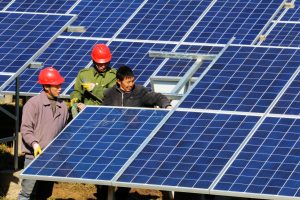China’s battery complex poses complex tradeoffs for Western interests. On one hand, Chinese-made lithium-ion batteries accelerate decarbonization objectives, especially for the electricity grid. On the other hand, China’s dominance of a critical clean tech industry would severely harm Western economic interests. Additionally, synergies between China’s shipbuilding, drone-making, and battery industries pose military risks to the Washington and Brussels-led democracies, given batteries’ importance for diesel-electric submarines, unmanned maritime platforms, and aerial drones.
Complicating matters even more, China’s battery complex will likely reduce its long-term demand for Russian hydrocarbons and strain its relations with Moscow.
China is already deploying massive amounts of solar and complementary grid storage batteries. While standalone solar only generates electricity during sunlight hours, solar paired with batteries can discharge electrons during evening hours, when electricity demand and prices are higher. By shifting solar-generated power to higher-priced times of the day, storage batteries ease transmission bottlenecks, improving the economics of solar.
In 2023, China’s cumulative deployments of utility-scale/distributed solar and “new energy storage projects,” reached 609 gigawatts (GW) and 31.4 GW respectively, with lithium-ion battery capacity comprising most new energy storage. For reference, by the end of 2023 the United States had cumulatively installed 177 GW of solar and 16 GW of battery storage.
China’s electricity profile is shifting rapidly, but solar production is starting from a low base, with coal still dominant. In 2023, solar power made up just 6 percent of China’s electricity mix, while coal exceeded 60 percent. For comparison, the U.S. electricity mix also stood at 6 percent solar but only 16 percent coal. Parenthetically, it’s important to emphasize that electricity and energy are not synonymous, as the latter encompasses transportation and heating, not just electricity.
China can only deploy so much solar capacity for its electricity sector before it runs into the “solar wall,” the point at which incremental generation is uneconomic, cannot be physically accommodated by existing transmission, or both. The U.S. state of California has one of the world’s most mature solar markets and has faced significant “curtailment,” or periods when electricity generation is suppressed by price signals, physical oversupply, or both. Batteries help mitigate curtailment, as the experience of California’s electricity regulator, the California Independent System Operator (CAISO) shows. CAISO ran into the “solar wall” at levels below 20 percent grid penetration, but batteries are enabling California to increase solar’s share on the grid without increasing curtailment.
China’s overall solar penetration will take years to reach California’s levels. Given that China’s best solar potential is in the north and western parts of the country, these regions will be the first in China to experience the “solar wall.”
China is motivated to expand solar power and push back the solar wall due to industrial overcapacity, especially in solar PV manufacturing, as well as energy security objectives. Another motivating factors are the water constraints in the north; crucially, unlike coal or natural gas, solar does not use cooling water. China will likely push back the solar wall and increase solar’s penetration rate on the electricity grid via three strategies.
First, China will deploy batteries. Chinese companies will use large volumes of lithium-ion and, potentially, alternative battery chemistries to mitigate curtailment.
Second, China will seek to advance battery technology. Long-duration energy storage is expected to progress. In the United States, 90 percent of new storage capacity – with almost all of that capacity consisting of lithium-ion batteries – has duration of 4 hours or less. That will change. Significant, potentially groundbreaking, technical and commercial developmental advances in long duration energy storage appear likely. Examples include Australia’s first eight-hour battery and a U.S. startup’s multi-day iron-air storage.
Finally, aligning economic activity with sunlight hours could boost solar usage. Essentially, solar alignment time would change the clocks to match economic activity and electricity demand with sunlight hours. In the summer, this could mean sundown could occur at 10 p.m. or later, as electricity demand tends to peak at around 6 p.m. (at least in the United States – Chinese diurnal and seasonal electricity data is much less transparent).
Increasing use of solar, batteries, wind, and other clean energy technologies will reduce emissions and decrease China’s dependence on electricity-sector relevant imports of coal and natural gas, including from Russia.
This shift could halt the proposed Power of Siberia 2 pipeline, end Russian coal exports, and challenge imports via the existing Power of Siberia 1 pipeline.
It’s worth noting that Chinese natural gas demand, especially in the north, is driven by heating and industry, not power. Still, the mass deployment of electricity-relevant clean energy technologies, including heat pumps and battery-enabled green hydrogen, will directly limit or even curtail Chinese demand for Russian natural gas imports.
Batteries are also crucial for accelerating China’s EV industry, which could threaten Russian crude oil exports, especially as battery technology improves.
China’s adoption of renewables and continued commitment to domestic coal production will limit its hydrocarbon imports, including from Russia, strengthening Beijing’s leverage in the relationship.
Beijing and Moscow remain very unlikely to break with one another, even over the long term, largely owing to their mutual animosity toward the Washington and Brussels-led world order. Still, China’s development of batteries and other clean energy technologies will ultimately constrain Russia’s hydrocarbon complex, complicating ties between the world’s two most powerful authoritarian countries.

































